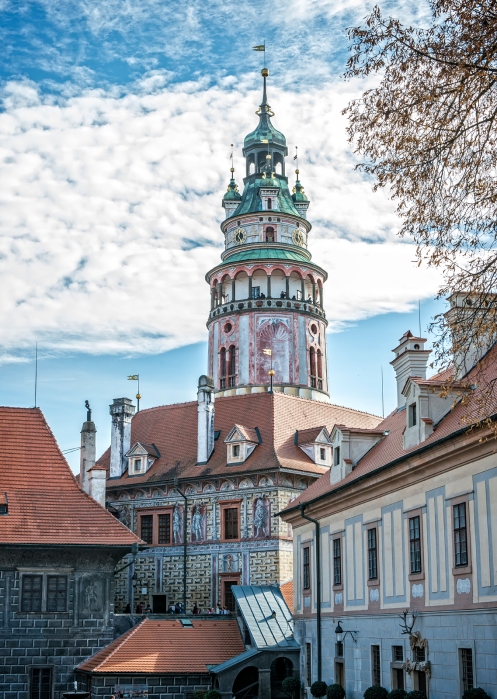architecture, Baroque, Bohemia, bridge, castle, Cesky Krumlov, church, cityscape, Czech Republic, Czechoslovakia, Europe, Gothic, landscape, medieval, Moldau, Prague, Renaissance, river, spire, St. Jost, St. Vitus, tower, town, trompe l'oeil, UNESCO, village, Vltava, World Heritage
A Visit to Cesky Krumlov

The town of Cesky Krumlov is a UNESCO World Heritage site located on the banks of the Vltava River (the Moldau) in the South Bohemian region of the Czech Republic, about 2-1/2 hours south of Prague by car. It was built during the 14th through the 17th centuries, primarily in Renaissance style, with additional gothic and baroque elements. It is situated around a 13th century castle which is the second largest in the Czech Republic (after the Prague castle), comprising a total of 40 buildings. UNESCO characterizes the town as “an outstanding example of a small central European medieval town whose architectural heritage has remained intact thanks to its peaceful evolution over more than five centuries.”
The original gothic castle, around which the town of Cesky Krumlov was built, was founded by the Lords of Krumlov around 1253. In 1302, the castle and town were inherited by the Rosenbergs, an aristocratic family related to the founders. The House of Rosenberg ruled Cesky Krumlov until 1602. During this period, the castle was rebuilt in Renaissance style, and the town experienced its greatest prosperity, with rapid economic development, construction of new buildings, and the expansion of trade with other cities in the region.
In 1602, the Emperor Rudolf II von Habsburg bought the Krumlov dominion. In 1622, it was transferred to the Eggenberg family. In the 1680’s, under the rule of Johann Christian I von Eggenberg, farming, construction, and the arts flourished, helping Cesky Krumlov rise out of a period of stagnation that resulted from the Thirty Years’ War (1618-1648). He also undertook extensive renovations and expansions of the castle in the baroque style.
In 1719, a new dynasty, the Schwarzenbergs, inherited Cesky Krumlov. In the second generation of their rule, Joseph Adam zu Schwarzenberg undertook an extensive modification of the castle in the baroque style.
After World War I, Cesky Krumlov became part of Czechoslovakia. In 1938 it was annexed by Nazi Germany, as part of the Sudetenland according to the Munich agreement. After World War II, the town’s German-speaking population was expelled and it was returned to Czechoslovakia.
During the Communist era of Czechoslovakia, Cesky Krumlov fell into disrepair, but since the Velvet Revolution of 1989 much of the town’s former beauty has been restored. In 1992 it was designated as a UNESCO World Heritage site and it is now a major holiday destination popular with tourists.
Our hotel in Prague (the Golden Well — highly recommended!) arranged for a one-day tour of Cesky Krumlov with a driver and guide. There was only one other tourist in our group besides my wife and me. Upon our little group’s initial approach to Cesky Krumlov, we caught a glimpse of the town through the trees (you may click on any photo in this article to see a larger version):
The steeple in the center of the photo belongs to the Church of St. Vitus, a gothic structure set in mostly Renaissance surroundings.
As we approached the castle, we came to a parapet that serves as an ideal lookout site. My wide angle lens served to sweep a large part of the town into a single shot:
As we approached the entrance to the castle, we saw other impressive views of the town:
We proceeded through the castle. Seen below is a portion of an internal courtyard decorated in characteristic Renaissance trompe l’oeil style:
The seemingly three-dimensional stone blocks in the walls in the photo above are actually not stone blocks at all but are painted on a flat surface.
We walked through an arched tunnel that separates two internal courtyards in the castle:
Different parts of the castle are also joined by an enclosed connecting bridge supported by a multi-tiered set of arches:
Here is a view of one of the principal buildings of the castle, from a pedestrian bridge over the Vltava River:
Shown in the photo below is the beautiful St. Jost Church:
Shown in the next photo is the castle’s lookout tower as viewed from a street in the town. Note the Renaissance style decoration on the tower and the walls of the building below it:
Here is a shot of the castle tower and the St. Jost Church together:
In this photo, a large part of the castle is visible, along with the St. Jost Church and other buildings situated along the banks of the Vltava River:
We also visited the gothic St. Vitus Church, of which this is an internal view:
Here are some of the other breathtakingly gorgeous views one sees from the street inside the town:
For visitors to Prague, one-day and two-day group and private tours to Cesky Krumlov are available from a variety of tour companies. The trip is well worth the effort.
The photos shown in this article and other photos of Cesky Krumlov are available for viewing and purchase in full original resolution in the Cesky Krumlov Gallery of my photography website. For further information about my photography, please also visit my photography Facebook page.
Phil Haber
Copyright © 2016 Philip A. Haber
From → Travels in Central Europe
Leave a comment Cancel reply
This site uses Akismet to reduce spam. Learn how your comment data is processed.

















These are beautiful photos Phil!! And I very much appreciated the background. Sandy and I were in the Czech Republic a few years ago but not get this town. Hugs to Margot and all the family! Xo Ron
Sent from my iPad
>
Thanks Ron!
Absolutely gorgeous pictures!